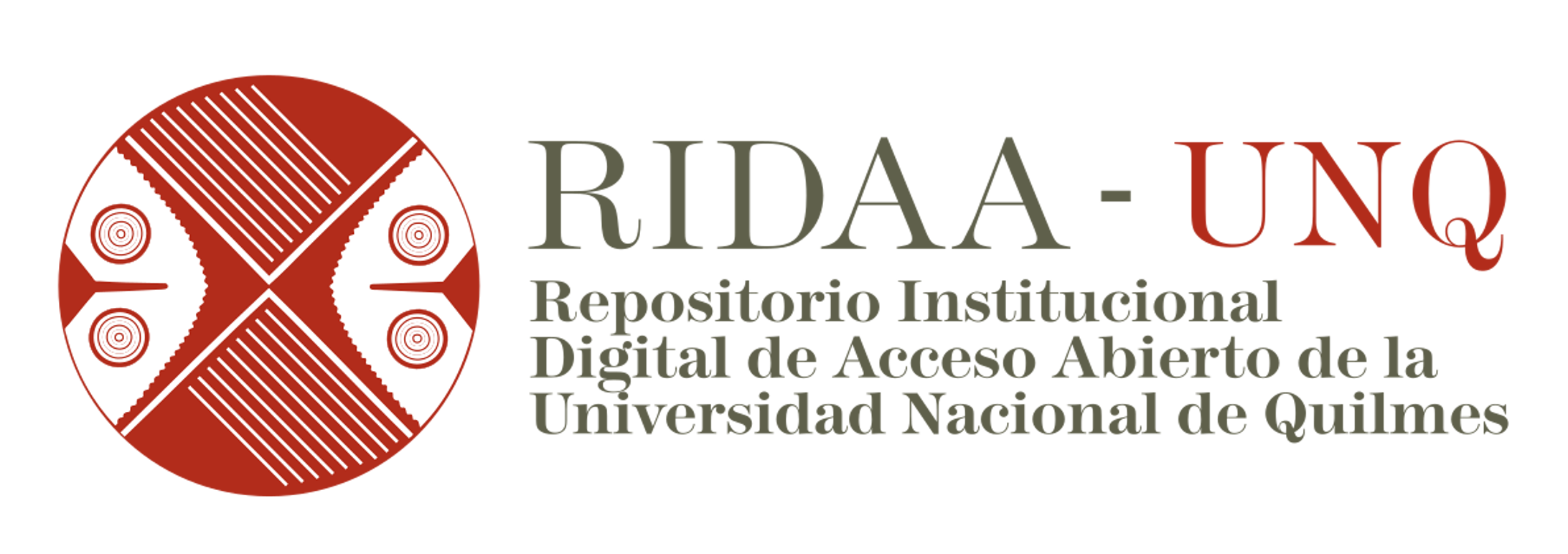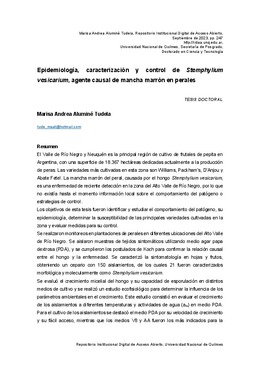Epidemiología, caracterización y control de Stemphylium vesicarium, agente causal de mancha marrón en perales
Abstract
El Valle de Río Negro y Neuquén es la principal región de cultivo de frutales de pepita en Argentina, con una superficie de 18.367 hectáreas dedicadas actualmente a la producción de peras. Las variedades más cultivadas en esta zona son Williams, Packham's, D'Anjou y Abate Fetel. La mancha marrón del peral, causada por el hongo Stemphylium vesicarium, es una enfermedad de reciente detección en la zona del Alto Valle de Río Negro, por lo que no existía hasta el momento información local sobre el comportamiento del patógeno o estrategias de control.
Los objetivos de esta tesis fueron identificar y estudiar el comportamiento del patógeno, su epidemiología, determinar la susceptibilidad de las principales variedades cultivadas en la zona y evaluar medidas para su control.
Se realizaron monitoreos en plantaciones de perales en diferentes ubicaciones del Alto Valle de Río Negro. Se aislaron muestras de tejidos sintomáticos utilizando medio agar papa dextrosa (PDA), y se cumplieron los postulados de Koch para confirmar la relación causal entre el hongo y la enfermedad. Se caracterizó la sintomatología en hojas y frutos, obteniendo un cepario con 150 aislamientos, de los cuales 21 fueron caracterizados morfológica y molecularmente como Stemphylium vesicarium.
Se evaluó el crecimiento micelial del hongo y su capacidad de esporulación en distintos medios de cultivo y se realizó un estudio ecofisiológico para determinar la influencia de los parámetros ambientales en el crecimiento. Este estudio consistió en evaluar el crecimiento de los aislamientos a diferentes temperaturas y actividades de agua (aw) en medio PDA. Para el cultivo de los aislamientos se destacó el medio PDA por su velocidad de crecimiento y su fácil acceso, mientras que los medios V8 y AA fueron los más indicados para la producción de conidios. El estudio ecofisiológico indicó que el mayor crecimiento se dio a 25 y 30 °C y en aw de 0,99.
Durante tres temporadas, se estudió el comportamiento del patógeno, siguiendo el desarrollo de sus estructuras invernantes y registrando la aparición de síntomas. Se recolectaron hojas con síntomas de mancha marrón a fines de marzo de cada año y se colocaron en bolsas de malla de polipropileno de 70 x 30 cm en el interfilar a partir del 1 de abril. Los muestreos se realizaron de julio a diciembre, contabilizando el número de pseudotecios en cada lámina foliar y extrayendo de 50 a 100 pseudotecios para determinar su madurez según escalas reportadas para hongos ascomicetos. Los pseudotecios se desarrollaron durante el invierno en las hojas de peral de la temporada anterior. Las temperaturas bajas y humedad elevada favorecieron su evolución. La diferenciación de las ascosporas ocurrió entre los meses de julio y agosto. En el período comprendido entre octubre y noviembre, se registró una cantidad considerable de ascosporas maduras y disponibles para liberarse.
Se evaluó la patogenicidad de los aislamientos en frutos de la variedad D'Anjou, y se seleccionó la cepa más patogénica para llevar a cabo los ensayos de inoculación. Se realizó un estudio de susceptibilidad varietal utilizando hojas y frutos de las principales variedades: Williams, Packham's, D'Anjou y Abate Fetel. Según los resultados obtenidos, se determinó que las variedades más susceptibles a la infección son Abate Fetel y D'Anjou, mientras que Packham's mostró un comportamiento intermedio y Williams fue la menos susceptible, con valores menores de incidencia y severidad. Además, se evaluaron los frutos y hojas en diferentes etapas de desarrollo para determinar su mayor susceptibilidad, observando que los frutos y hojas jóvenes fueron los más afectados.
Para investigar el control de la enfermedad, se realizaron ensayos in vitro para inhibir el crecimiento micelial y la germinación de esporas utilizando cuatro fungicidas, determinando los valores de EC50 para cada uno. Además, se llevaron a cabo ensayos in vitro con estos fungicidas, aplicándolos de manera preventiva y curativa en frutos, para determinar las estrategias más recomendables para su manejo. Este estudio permitió identificar a Bellis® (pyraclostrobin + boscalid), Ziram® (ziram), y Merpan® (captan), como posibles herramientas de manejo de la mancha marrón del peral. Bellis® fue el fungicida más eficaz para prevenir la germinación de esporas y el crecimiento del micelio, demostrando EC50 menores que el resto. Ziram®, fue el segundo mejor fungicida. Los tratamientos preventivos fueron los más efectivos para reducir la incidencia y la severidad de la mancha marrón. Así mismo, se realizaron tratamientos preventivos a campo durante dos temporadas con los fungicidas Bellis® y Ziram®, obteniendo buenos niveles de control de la enfermedad.
Los resultados obtenidos de este trabajo de tesis proporcionan información importante para el manejo de la mancha marrón del peral en Argentina, contribuyendo así a la sustentabilidad de la producción de peras en la región del Alto Valle de Río Negro. The Rio Negro and Neuquén Valley is the main apple-producing region in Argentina, with a current cultivated area of 18,367 hectares dedicated to pear production. The main varieties grown in this area include Williams, Packham's, D'Anjou, and Abate Fetel. Brown spot of pear, caused by the fungus Stemphylium vesicarium, was recently detected in the Alto Valle de Río Negro region, where there was no local information available about the behavior of the pathogen or control strategies.
The objectives of this thesis were to identify and study the behavior of the pathogen, its epidemiology, determine the susceptibility of the main varieties grown in the region, and evaluate control measures.
Monitoring was conducted in pear orchards at different locations in the Alto Valle de Río Negro. Symptomatic tissue samples were isolated using potato dextrose agar medium, and Koch's postulates were fulfilled to confirm the causal relationship between the fungus and the disease. Symptomatology on leaves and fruits was characterized, resulting in a collection of 150 isolates, from which 21 were morphologically and molecularly characterized as Stemphylium vesicarium.
Mycelial growth of the fungus and its sporulation capacity were evaluated in different culture media, and an eco-physiological study was conducted to determine the influence of environmental parameters on growth. This study involved assessing the isolates' growth at different temperatures and water activities (aw) in potato dextrose agar medium. The PDA medium was chosen for isolates' cultivation due to its fast growth rate and easy accessibility, while V8 and AA media were most suitable for conidia production. The eco-physiological study indicated that the highest growth occurred at 25 and 30°C and at an aw of 0.99.
Over three seasons, the behavior of the pathogen was studied by monitoring the development of its overwintering structures and recording symptom appearance. Leaves with brown spot symptoms were collected at the end of March each year and placed in polypropylene mesh bags (70 x 30 cm) in the tree interspaces starting from April 1st. Sampling was conducted from July to December, during which the number of pseudothecia on each leaf was counted, and 50 to 100 pseudothecia were extracted to determine their maturity stage based on reported scales for ascomycete fungal pseudothecia development. Pseudothecia developed during the winter on the leaves of the previous season's pear trees. Low temperatures and high humidity favored their evolution. The differentiation of ascospores occurred between the months of July and August. In the period between October and November, a considerable amount of mature ascospores was recorded and available for release.
The pathogenicity of the isolates on Beurré D'Anjou fruits was evaluated, and the most pathogenic strain was selected for inoculation assays. A varietal susceptibility study was conducted using leaves and fruits of the main varieties, including Williams, Packham's, D'Anjou, and Abate Fetel. The results confirmed that Abate Fetel and D'Anjou were the most susceptible varieties, while Packham's showed intermediate behavior, and Williams was the least susceptible, exhibiting lower incidence and severity values. Additionally, fruits and leaves at different developmental stages were evaluated to determine their highest susceptibility, with young fruits being the most affected.
To investigate disease control, in vitro assays were performed to inhibit mycelial growth and spore germination using four fungicides, determining their respective EC50 values. Furthermore, these fungicides were applied in vitro in preventive and curative treatments to determine the most recommended strategies for disease management. This study enabled the identification of Bellis® (pyraclostrobin + boscalid), Ziram® (ziram), and Merpan® (captan), as potential management tools for brown spot of pear. Bellis® proved to be the most effective fungicide in inhibiting spore germination and mycelial growth, displaying lower EC50 values than the others. Ziram® ranked as the second-best fungicide. Preventive treatments showed the highest efficacy in reducing the incidence and severity of brown spot of pear. Likewise, preventive field treatments were carried out over two seasons using the fungicides Bellis® and Ziram®, achieving effective disease control levels.
The findings from this thesis work provide crucial insights for effectively managing brown spot of pear in argentina, thus playing a significant role in promoting the sustainability of pear production in the Alto Valle de Río Negro region.

